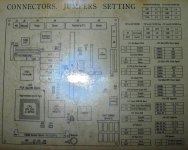Yes, on the 486SX 25 the multiplier is x1 so internal speed and external bus speed are the same: 25 MHz
That's true. I have done it with a soldered 486SX 25 without heatsink and without fan.
If you want to retain the "mistique" of 486 you can use an Intel Overdrive, which is a special 486DX2 or DX4 with heatsink included. The fastest model is: http://xhoba.x86-guide.com/en/collection/Intel-Overdrive-486DX4-100-(PGA168)-cpu-no5377.html
But again, to get the maximum 100 MHz you'll need to set external bus speed at 33 (its multiplier is x3).
About the eBay article, yes, the PODP5Vxx are the Pentium Overdrives for socket 2 & 3 486 boards, with xx being the speed. The BOXPODP5Vxx are the ones sold in beautiful box Probably an unboxed one will be cheaper, provided that you are not a box collector.
Probably an unboxed one will be cheaper, provided that you are not a box collector.
Take a look at these 2 different blue sockets:
http://www.computerhope.com/jargon/o/overdriv.htm
http://en.wikipedia.org/wiki/Socket_2
You don't need to count the pins, but notice that the 1st one has 3 rows of pins, while the 2nd one has 4. The Pentium Overdrive was officially designed for the 2nd one.
Yeah, if there is a jumper to change the BUS speed from 25 to 33 MHz, you do that, even if you don't change the CPU. Almost every 486SX-25 can work fine at 33 MHz. My 486SX-25 board from IBM has no jumper to set the clock and the only option is to change the 50MHz oscillator to an 66MHz one.
That's true. I have done it with a soldered 486SX 25 without heatsink and without fan.
If you want to retain the "mistique" of 486 you can use an Intel Overdrive, which is a special 486DX2 or DX4 with heatsink included. The fastest model is: http://xhoba.x86-guide.com/en/collection/Intel-Overdrive-486DX4-100-(PGA168)-cpu-no5377.html
But again, to get the maximum 100 MHz you'll need to set external bus speed at 33 (its multiplier is x3).
About the eBay article, yes, the PODP5Vxx are the Pentium Overdrives for socket 2 & 3 486 boards, with xx being the speed. The BOXPODP5Vxx are the ones sold in beautiful box
Take a look at these 2 different blue sockets:
http://www.computerhope.com/jargon/o/overdriv.htm
http://en.wikipedia.org/wiki/Socket_2
You don't need to count the pins, but notice that the 1st one has 3 rows of pins, while the 2nd one has 4. The Pentium Overdrive was officially designed for the 2nd one.

